Food Safety Management Report: HND in Hospitality, Unit 31
VerifiedAdded on 2020/12/30
|12
|3249
|455
Report
AI Summary
This report on food safety management, prepared for a Higher National Diploma (HND) in Hospitality, explores crucial aspects of ensuring food safety in the hospitality industry. It begins by defining food safety management and discussing controls to prevent physical and chemical contamination, differentiating between food poisoning and food-borne infections. The report then delves into food spoilage agents, methods of food preservation, and the effectiveness of these methods. It covers key steps in temperature control systems, safe food storage methods, and the importance of personal hygiene, cleaning, and disinfection. Additionally, it addresses pest control, hygienic design and construction of food premises, and the significance of training as a quality assurance mechanism. The report also includes a food hazard risk assessment, a food safety control system, and a food safety guide for legislative compliance, providing a comprehensive overview of food safety practices.
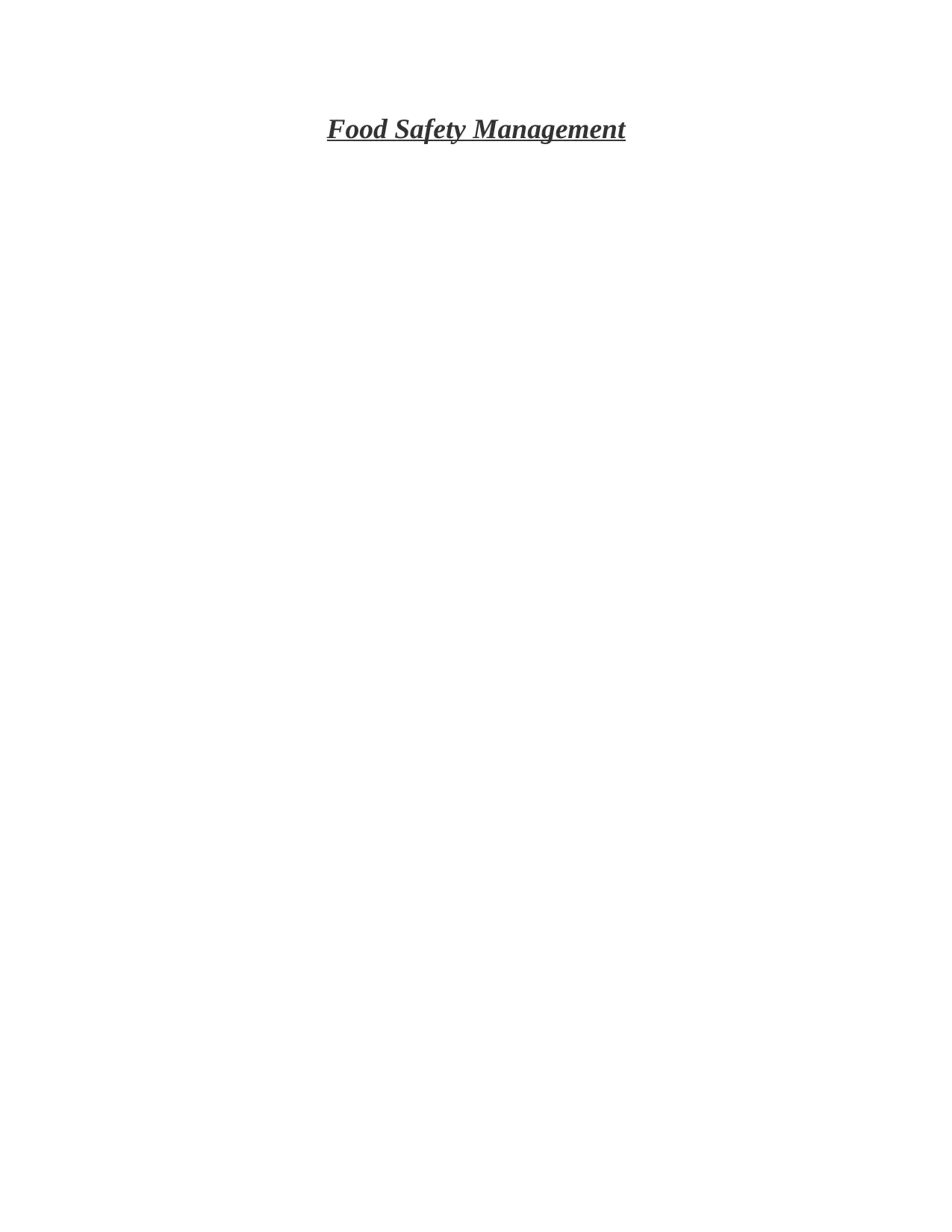
Food Safety Management
Paraphrase This Document
Need a fresh take? Get an instant paraphrase of this document with our AI Paraphraser
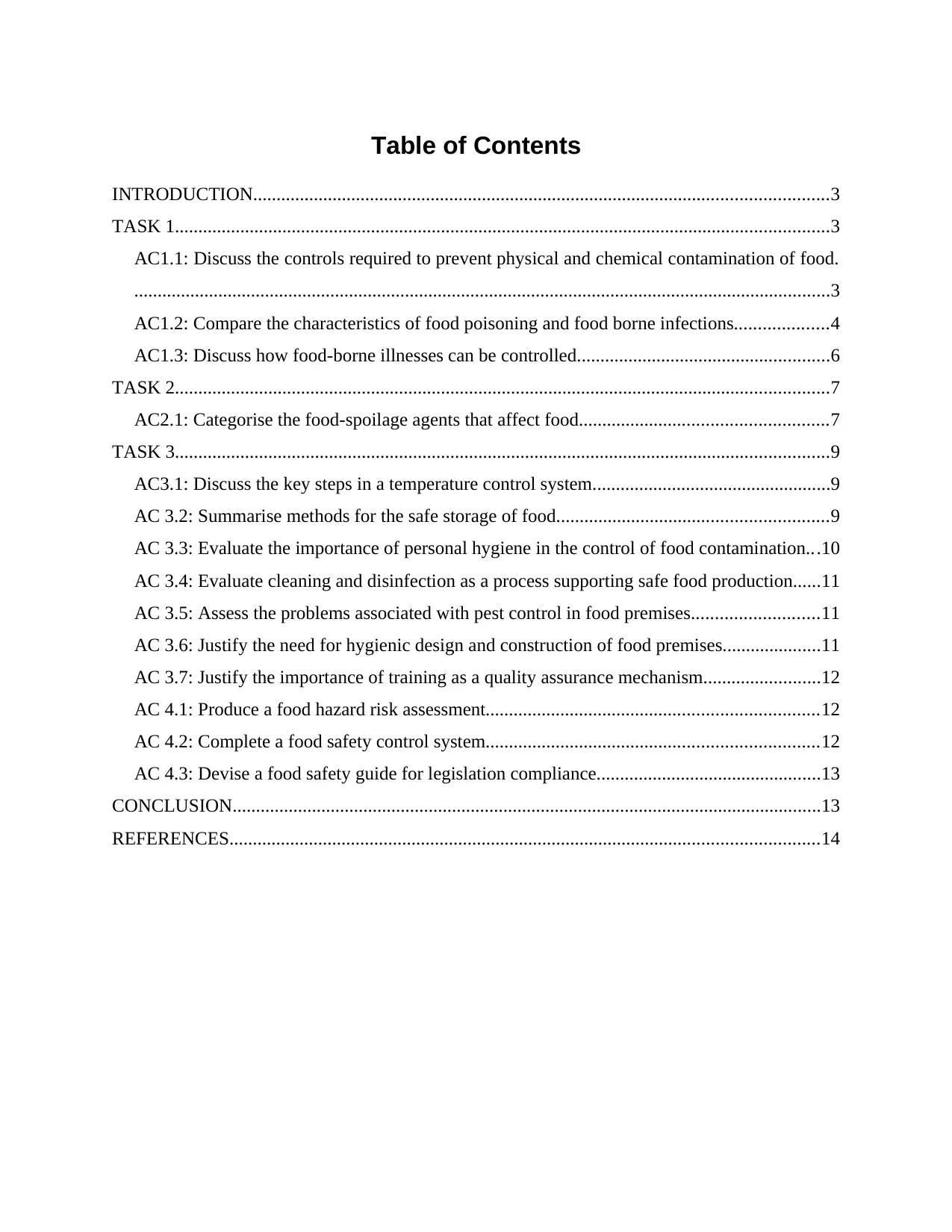
Table of Contents
INTRODUCTION...........................................................................................................................3
TASK 1............................................................................................................................................3
AC1.1: Discuss the controls required to prevent physical and chemical contamination of food.
.....................................................................................................................................................3
AC1.2: Compare the characteristics of food poisoning and food borne infections....................4
AC1.3: Discuss how food-borne illnesses can be controlled......................................................6
TASK 2............................................................................................................................................7
AC2.1: Categorise the food-spoilage agents that affect food.....................................................7
TASK 3............................................................................................................................................9
AC3.1: Discuss the key steps in a temperature control system...................................................9
AC 3.2: Summarise methods for the safe storage of food..........................................................9
AC 3.3: Evaluate the importance of personal hygiene in the control of food contamination...10
AC 3.4: Evaluate cleaning and disinfection as a process supporting safe food production......11
AC 3.5: Assess the problems associated with pest control in food premises...........................11
AC 3.6: Justify the need for hygienic design and construction of food premises.....................11
AC 3.7: Justify the importance of training as a quality assurance mechanism.........................12
AC 4.1: Produce a food hazard risk assessment.......................................................................12
AC 4.2: Complete a food safety control system.......................................................................12
AC 4.3: Devise a food safety guide for legislation compliance................................................13
CONCLUSION..............................................................................................................................13
REFERENCES..............................................................................................................................14
INTRODUCTION...........................................................................................................................3
TASK 1............................................................................................................................................3
AC1.1: Discuss the controls required to prevent physical and chemical contamination of food.
.....................................................................................................................................................3
AC1.2: Compare the characteristics of food poisoning and food borne infections....................4
AC1.3: Discuss how food-borne illnesses can be controlled......................................................6
TASK 2............................................................................................................................................7
AC2.1: Categorise the food-spoilage agents that affect food.....................................................7
TASK 3............................................................................................................................................9
AC3.1: Discuss the key steps in a temperature control system...................................................9
AC 3.2: Summarise methods for the safe storage of food..........................................................9
AC 3.3: Evaluate the importance of personal hygiene in the control of food contamination...10
AC 3.4: Evaluate cleaning and disinfection as a process supporting safe food production......11
AC 3.5: Assess the problems associated with pest control in food premises...........................11
AC 3.6: Justify the need for hygienic design and construction of food premises.....................11
AC 3.7: Justify the importance of training as a quality assurance mechanism.........................12
AC 4.1: Produce a food hazard risk assessment.......................................................................12
AC 4.2: Complete a food safety control system.......................................................................12
AC 4.3: Devise a food safety guide for legislation compliance................................................13
CONCLUSION..............................................................................................................................13
REFERENCES..............................................................................................................................14
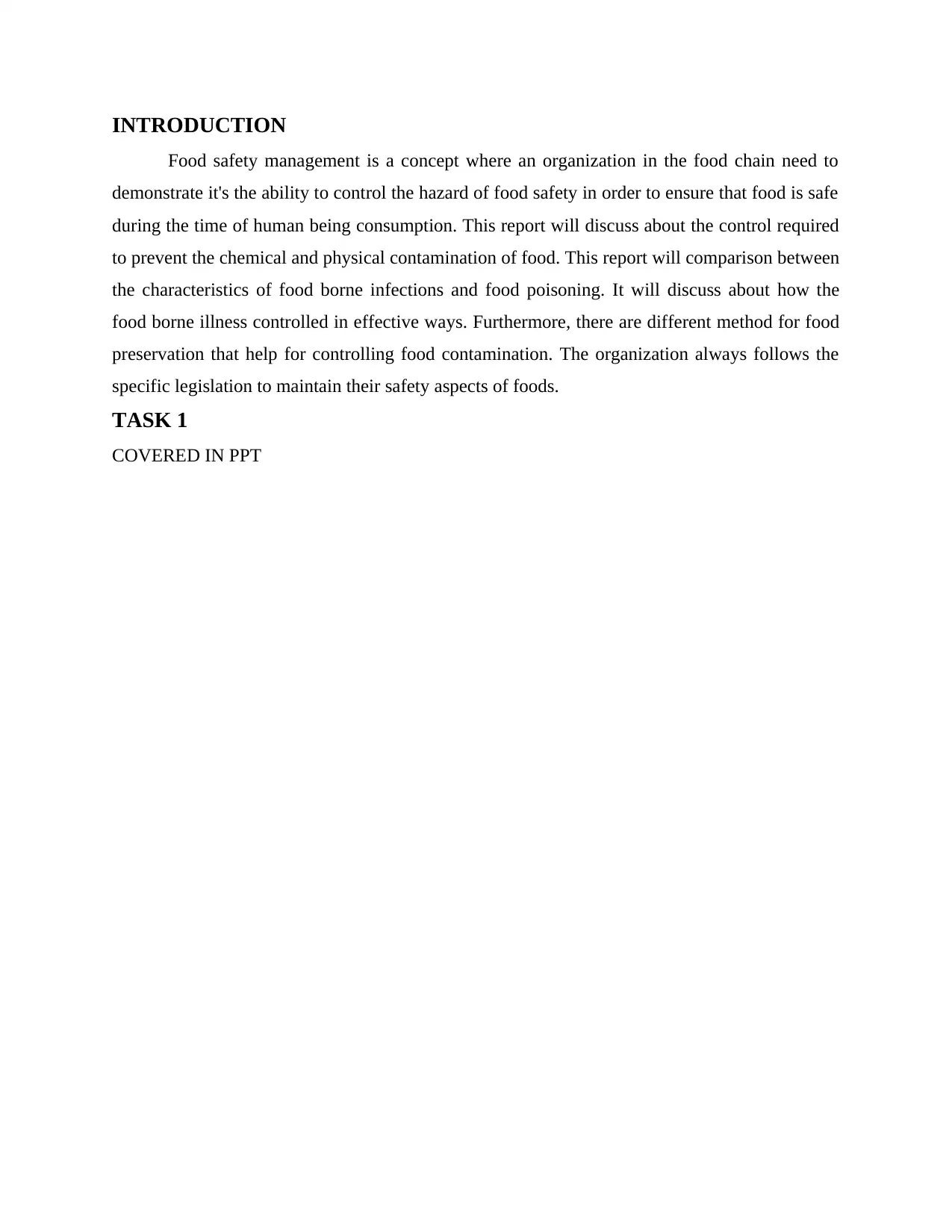
INTRODUCTION
Food safety management is a concept where an organization in the food chain need to
demonstrate it's the ability to control the hazard of food safety in order to ensure that food is safe
during the time of human being consumption. This report will discuss about the control required
to prevent the chemical and physical contamination of food. This report will comparison between
the characteristics of food borne infections and food poisoning. It will discuss about how the
food borne illness controlled in effective ways. Furthermore, there are different method for food
preservation that help for controlling food contamination. The organization always follows the
specific legislation to maintain their safety aspects of foods.
TASK 1
COVERED IN PPT
Food safety management is a concept where an organization in the food chain need to
demonstrate it's the ability to control the hazard of food safety in order to ensure that food is safe
during the time of human being consumption. This report will discuss about the control required
to prevent the chemical and physical contamination of food. This report will comparison between
the characteristics of food borne infections and food poisoning. It will discuss about how the
food borne illness controlled in effective ways. Furthermore, there are different method for food
preservation that help for controlling food contamination. The organization always follows the
specific legislation to maintain their safety aspects of foods.
TASK 1
COVERED IN PPT
⊘ This is a preview!⊘
Do you want full access?
Subscribe today to unlock all pages.

Trusted by 1+ million students worldwide
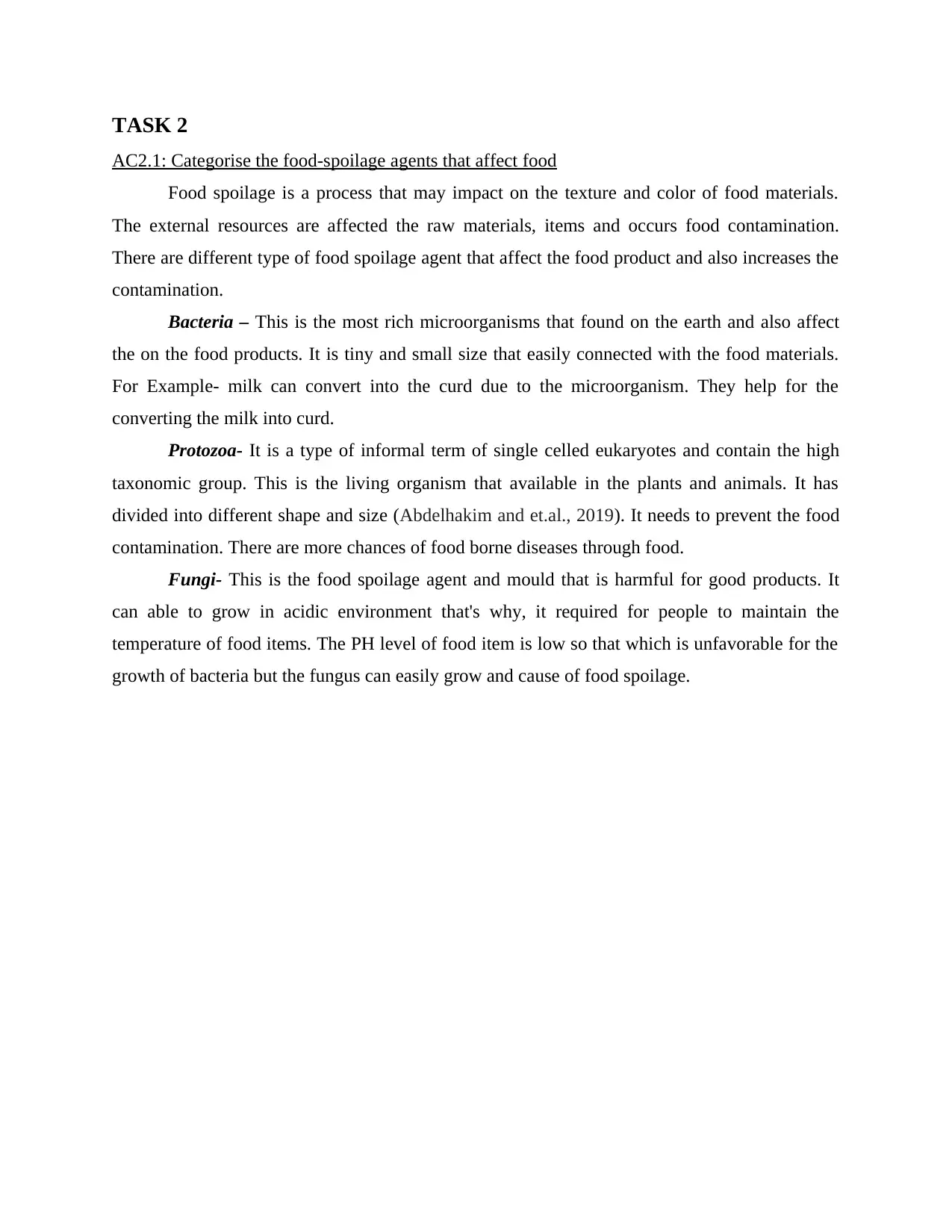
TASK 2
AC2.1: Categorise the food-spoilage agents that affect food
Food spoilage is a process that may impact on the texture and color of food materials.
The external resources are affected the raw materials, items and occurs food contamination.
There are different type of food spoilage agent that affect the food product and also increases the
contamination.
Bacteria – This is the most rich microorganisms that found on the earth and also affect
the on the food products. It is tiny and small size that easily connected with the food materials.
For Example- milk can convert into the curd due to the microorganism. They help for the
converting the milk into curd.
Protozoa- It is a type of informal term of single celled eukaryotes and contain the high
taxonomic group. This is the living organism that available in the plants and animals. It has
divided into different shape and size (Abdelhakim and et.al., 2019). It needs to prevent the food
contamination. There are more chances of food borne diseases through food.
Fungi- This is the food spoilage agent and mould that is harmful for good products. It
can able to grow in acidic environment that's why, it required for people to maintain the
temperature of food items. The PH level of food item is low so that which is unfavorable for the
growth of bacteria but the fungus can easily grow and cause of food spoilage.
AC2.1: Categorise the food-spoilage agents that affect food
Food spoilage is a process that may impact on the texture and color of food materials.
The external resources are affected the raw materials, items and occurs food contamination.
There are different type of food spoilage agent that affect the food product and also increases the
contamination.
Bacteria – This is the most rich microorganisms that found on the earth and also affect
the on the food products. It is tiny and small size that easily connected with the food materials.
For Example- milk can convert into the curd due to the microorganism. They help for the
converting the milk into curd.
Protozoa- It is a type of informal term of single celled eukaryotes and contain the high
taxonomic group. This is the living organism that available in the plants and animals. It has
divided into different shape and size (Abdelhakim and et.al., 2019). It needs to prevent the food
contamination. There are more chances of food borne diseases through food.
Fungi- This is the food spoilage agent and mould that is harmful for good products. It
can able to grow in acidic environment that's why, it required for people to maintain the
temperature of food items. The PH level of food item is low so that which is unfavorable for the
growth of bacteria but the fungus can easily grow and cause of food spoilage.
Paraphrase This Document
Need a fresh take? Get an instant paraphrase of this document with our AI Paraphraser
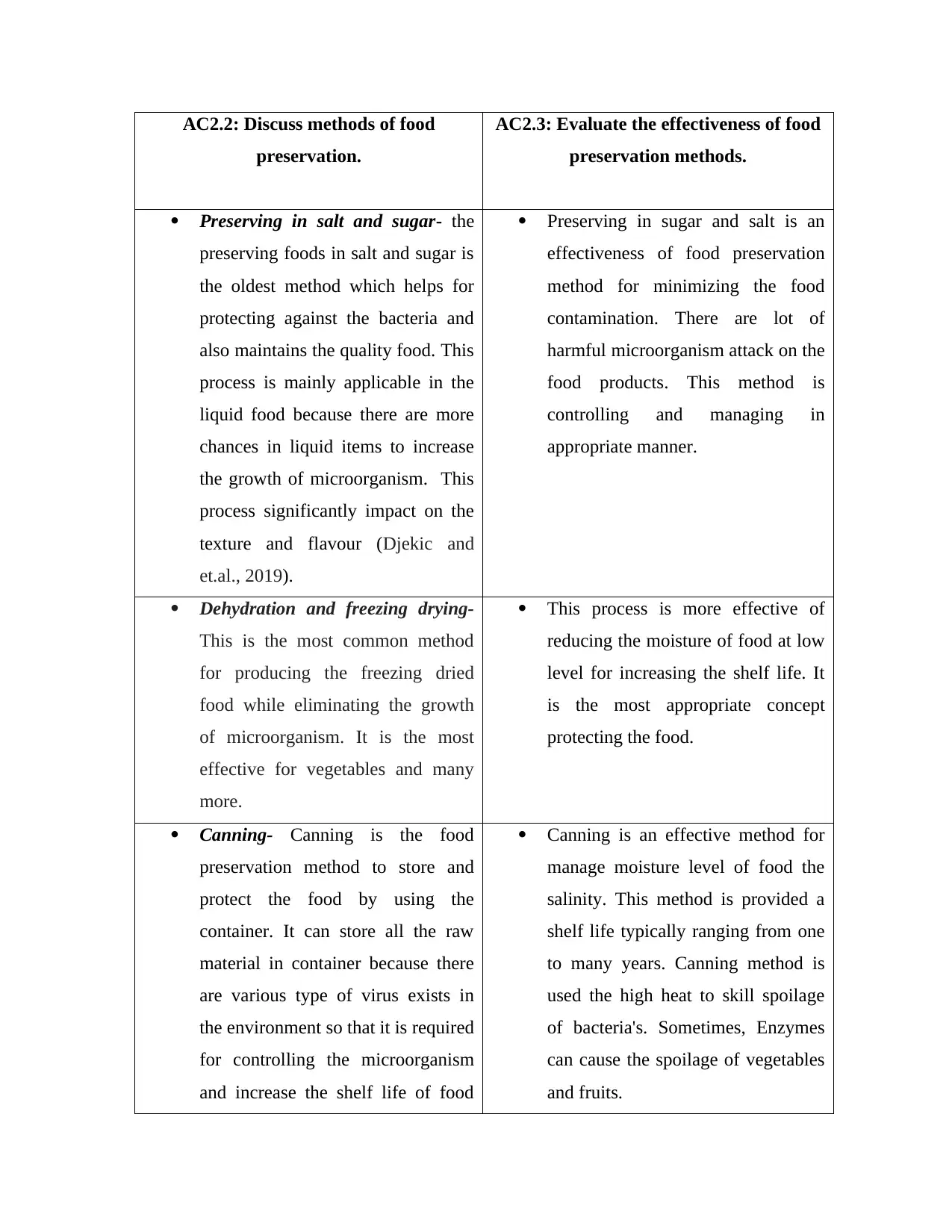
AC2.2: Discuss methods of food
preservation.
AC2.3: Evaluate the effectiveness of food
preservation methods.
Preserving in salt and sugar- the
preserving foods in salt and sugar is
the oldest method which helps for
protecting against the bacteria and
also maintains the quality food. This
process is mainly applicable in the
liquid food because there are more
chances in liquid items to increase
the growth of microorganism. This
process significantly impact on the
texture and flavour (Djekic and
et.al., 2019).
Preserving in sugar and salt is an
effectiveness of food preservation
method for minimizing the food
contamination. There are lot of
harmful microorganism attack on the
food products. This method is
controlling and managing in
appropriate manner.
Dehydration and freezing drying-
This is the most common method
for producing the freezing dried
food while eliminating the growth
of microorganism. It is the most
effective for vegetables and many
more.
This process is more effective of
reducing the moisture of food at low
level for increasing the shelf life. It
is the most appropriate concept
protecting the food.
Canning- Canning is the food
preservation method to store and
protect the food by using the
container. It can store all the raw
material in container because there
are various type of virus exists in
the environment so that it is required
for controlling the microorganism
and increase the shelf life of food
Canning is an effective method for
manage moisture level of food the
salinity. This method is provided a
shelf life typically ranging from one
to many years. Canning method is
used the high heat to skill spoilage
of bacteria's. Sometimes, Enzymes
can cause the spoilage of vegetables
and fruits.
preservation.
AC2.3: Evaluate the effectiveness of food
preservation methods.
Preserving in salt and sugar- the
preserving foods in salt and sugar is
the oldest method which helps for
protecting against the bacteria and
also maintains the quality food. This
process is mainly applicable in the
liquid food because there are more
chances in liquid items to increase
the growth of microorganism. This
process significantly impact on the
texture and flavour (Djekic and
et.al., 2019).
Preserving in sugar and salt is an
effectiveness of food preservation
method for minimizing the food
contamination. There are lot of
harmful microorganism attack on the
food products. This method is
controlling and managing in
appropriate manner.
Dehydration and freezing drying-
This is the most common method
for producing the freezing dried
food while eliminating the growth
of microorganism. It is the most
effective for vegetables and many
more.
This process is more effective of
reducing the moisture of food at low
level for increasing the shelf life. It
is the most appropriate concept
protecting the food.
Canning- Canning is the food
preservation method to store and
protect the food by using the
container. It can store all the raw
material in container because there
are various type of virus exists in
the environment so that it is required
for controlling the microorganism
and increase the shelf life of food
Canning is an effective method for
manage moisture level of food the
salinity. This method is provided a
shelf life typically ranging from one
to many years. Canning method is
used the high heat to skill spoilage
of bacteria's. Sometimes, Enzymes
can cause the spoilage of vegetables
and fruits.
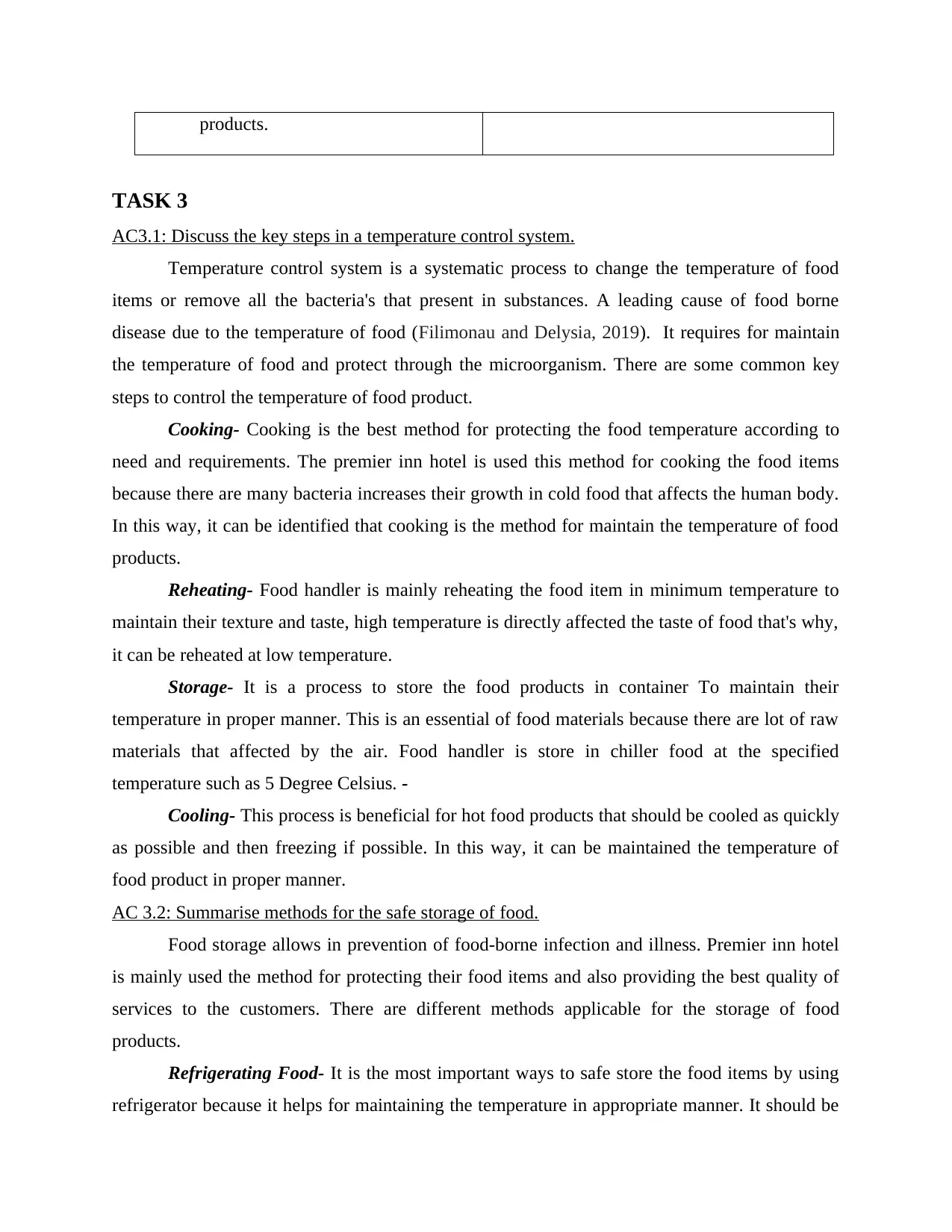
products.
TASK 3
AC3.1: Discuss the key steps in a temperature control system.
Temperature control system is a systematic process to change the temperature of food
items or remove all the bacteria's that present in substances. A leading cause of food borne
disease due to the temperature of food (Filimonau and Delysia, 2019). It requires for maintain
the temperature of food and protect through the microorganism. There are some common key
steps to control the temperature of food product.
Cooking- Cooking is the best method for protecting the food temperature according to
need and requirements. The premier inn hotel is used this method for cooking the food items
because there are many bacteria increases their growth in cold food that affects the human body.
In this way, it can be identified that cooking is the method for maintain the temperature of food
products.
Reheating- Food handler is mainly reheating the food item in minimum temperature to
maintain their texture and taste, high temperature is directly affected the taste of food that's why,
it can be reheated at low temperature.
Storage- It is a process to store the food products in container To maintain their
temperature in proper manner. This is an essential of food materials because there are lot of raw
materials that affected by the air. Food handler is store in chiller food at the specified
temperature such as 5 Degree Celsius. -
Cooling- This process is beneficial for hot food products that should be cooled as quickly
as possible and then freezing if possible. In this way, it can be maintained the temperature of
food product in proper manner.
AC 3.2: Summarise methods for the safe storage of food.
Food storage allows in prevention of food-borne infection and illness. Premier inn hotel
is mainly used the method for protecting their food items and also providing the best quality of
services to the customers. There are different methods applicable for the storage of food
products.
Refrigerating Food- It is the most important ways to safe store the food items by using
refrigerator because it helps for maintaining the temperature in appropriate manner. It should be
TASK 3
AC3.1: Discuss the key steps in a temperature control system.
Temperature control system is a systematic process to change the temperature of food
items or remove all the bacteria's that present in substances. A leading cause of food borne
disease due to the temperature of food (Filimonau and Delysia, 2019). It requires for maintain
the temperature of food and protect through the microorganism. There are some common key
steps to control the temperature of food product.
Cooking- Cooking is the best method for protecting the food temperature according to
need and requirements. The premier inn hotel is used this method for cooking the food items
because there are many bacteria increases their growth in cold food that affects the human body.
In this way, it can be identified that cooking is the method for maintain the temperature of food
products.
Reheating- Food handler is mainly reheating the food item in minimum temperature to
maintain their texture and taste, high temperature is directly affected the taste of food that's why,
it can be reheated at low temperature.
Storage- It is a process to store the food products in container To maintain their
temperature in proper manner. This is an essential of food materials because there are lot of raw
materials that affected by the air. Food handler is store in chiller food at the specified
temperature such as 5 Degree Celsius. -
Cooling- This process is beneficial for hot food products that should be cooled as quickly
as possible and then freezing if possible. In this way, it can be maintained the temperature of
food product in proper manner.
AC 3.2: Summarise methods for the safe storage of food.
Food storage allows in prevention of food-borne infection and illness. Premier inn hotel
is mainly used the method for protecting their food items and also providing the best quality of
services to the customers. There are different methods applicable for the storage of food
products.
Refrigerating Food- It is the most important ways to safe store the food items by using
refrigerator because it helps for maintaining the temperature in appropriate manner. It should be
⊘ This is a preview!⊘
Do you want full access?
Subscribe today to unlock all pages.

Trusted by 1+ million students worldwide
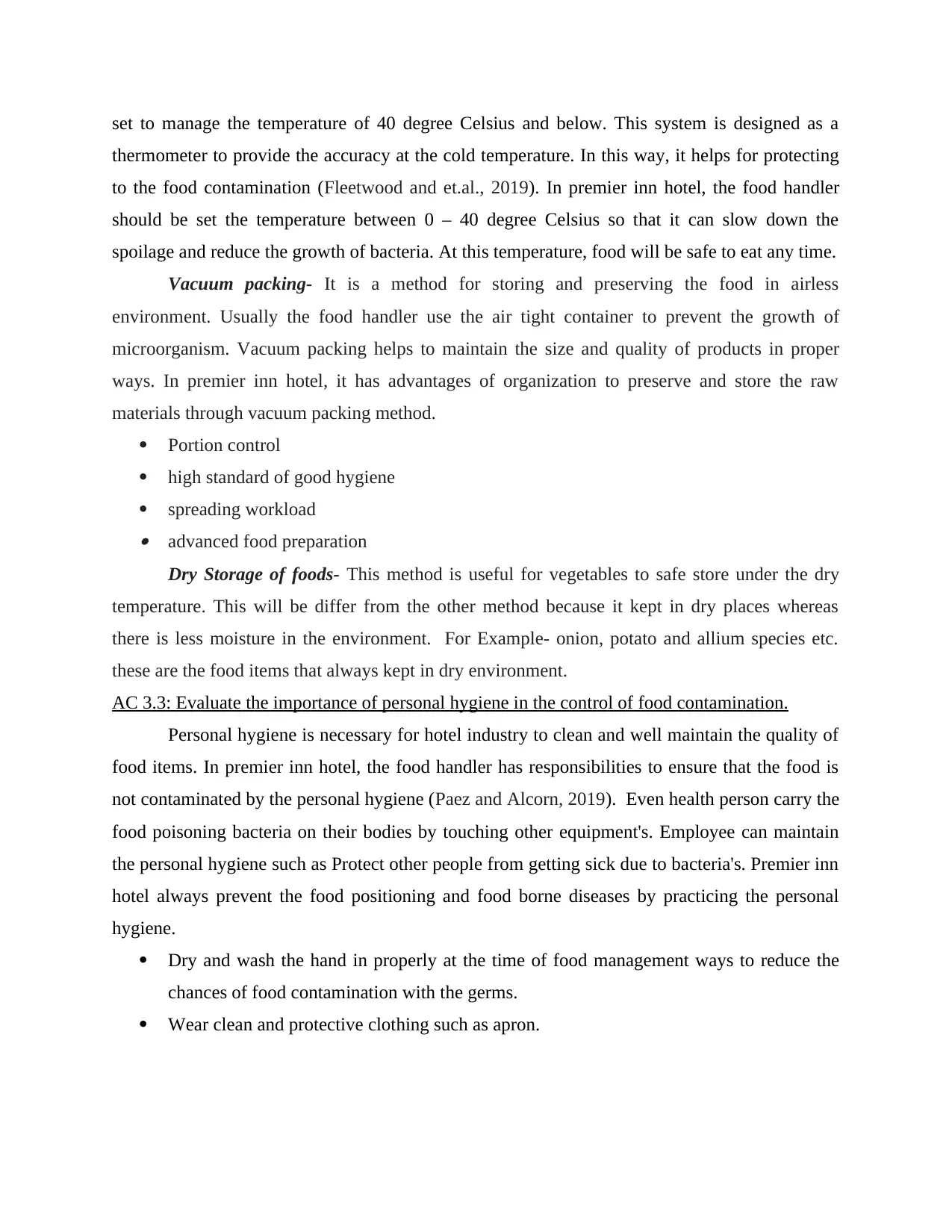
set to manage the temperature of 40 degree Celsius and below. This system is designed as a
thermometer to provide the accuracy at the cold temperature. In this way, it helps for protecting
to the food contamination (Fleetwood and et.al., 2019). In premier inn hotel, the food handler
should be set the temperature between 0 – 40 degree Celsius so that it can slow down the
spoilage and reduce the growth of bacteria. At this temperature, food will be safe to eat any time.
Vacuum packing- It is a method for storing and preserving the food in airless
environment. Usually the food handler use the air tight container to prevent the growth of
microorganism. Vacuum packing helps to maintain the size and quality of products in proper
ways. In premier inn hotel, it has advantages of organization to preserve and store the raw
materials through vacuum packing method.
Portion control
high standard of good hygiene
spreading workload advanced food preparation
Dry Storage of foods- This method is useful for vegetables to safe store under the dry
temperature. This will be differ from the other method because it kept in dry places whereas
there is less moisture in the environment. For Example- onion, potato and allium species etc.
these are the food items that always kept in dry environment.
AC 3.3: Evaluate the importance of personal hygiene in the control of food contamination.
Personal hygiene is necessary for hotel industry to clean and well maintain the quality of
food items. In premier inn hotel, the food handler has responsibilities to ensure that the food is
not contaminated by the personal hygiene (Paez and Alcorn, 2019). Even health person carry the
food poisoning bacteria on their bodies by touching other equipment's. Employee can maintain
the personal hygiene such as Protect other people from getting sick due to bacteria's. Premier inn
hotel always prevent the food positioning and food borne diseases by practicing the personal
hygiene.
Dry and wash the hand in properly at the time of food management ways to reduce the
chances of food contamination with the germs.
Wear clean and protective clothing such as apron.
thermometer to provide the accuracy at the cold temperature. In this way, it helps for protecting
to the food contamination (Fleetwood and et.al., 2019). In premier inn hotel, the food handler
should be set the temperature between 0 – 40 degree Celsius so that it can slow down the
spoilage and reduce the growth of bacteria. At this temperature, food will be safe to eat any time.
Vacuum packing- It is a method for storing and preserving the food in airless
environment. Usually the food handler use the air tight container to prevent the growth of
microorganism. Vacuum packing helps to maintain the size and quality of products in proper
ways. In premier inn hotel, it has advantages of organization to preserve and store the raw
materials through vacuum packing method.
Portion control
high standard of good hygiene
spreading workload advanced food preparation
Dry Storage of foods- This method is useful for vegetables to safe store under the dry
temperature. This will be differ from the other method because it kept in dry places whereas
there is less moisture in the environment. For Example- onion, potato and allium species etc.
these are the food items that always kept in dry environment.
AC 3.3: Evaluate the importance of personal hygiene in the control of food contamination.
Personal hygiene is necessary for hotel industry to clean and well maintain the quality of
food items. In premier inn hotel, the food handler has responsibilities to ensure that the food is
not contaminated by the personal hygiene (Paez and Alcorn, 2019). Even health person carry the
food poisoning bacteria on their bodies by touching other equipment's. Employee can maintain
the personal hygiene such as Protect other people from getting sick due to bacteria's. Premier inn
hotel always prevent the food positioning and food borne diseases by practicing the personal
hygiene.
Dry and wash the hand in properly at the time of food management ways to reduce the
chances of food contamination with the germs.
Wear clean and protective clothing such as apron.
Paraphrase This Document
Need a fresh take? Get an instant paraphrase of this document with our AI Paraphraser
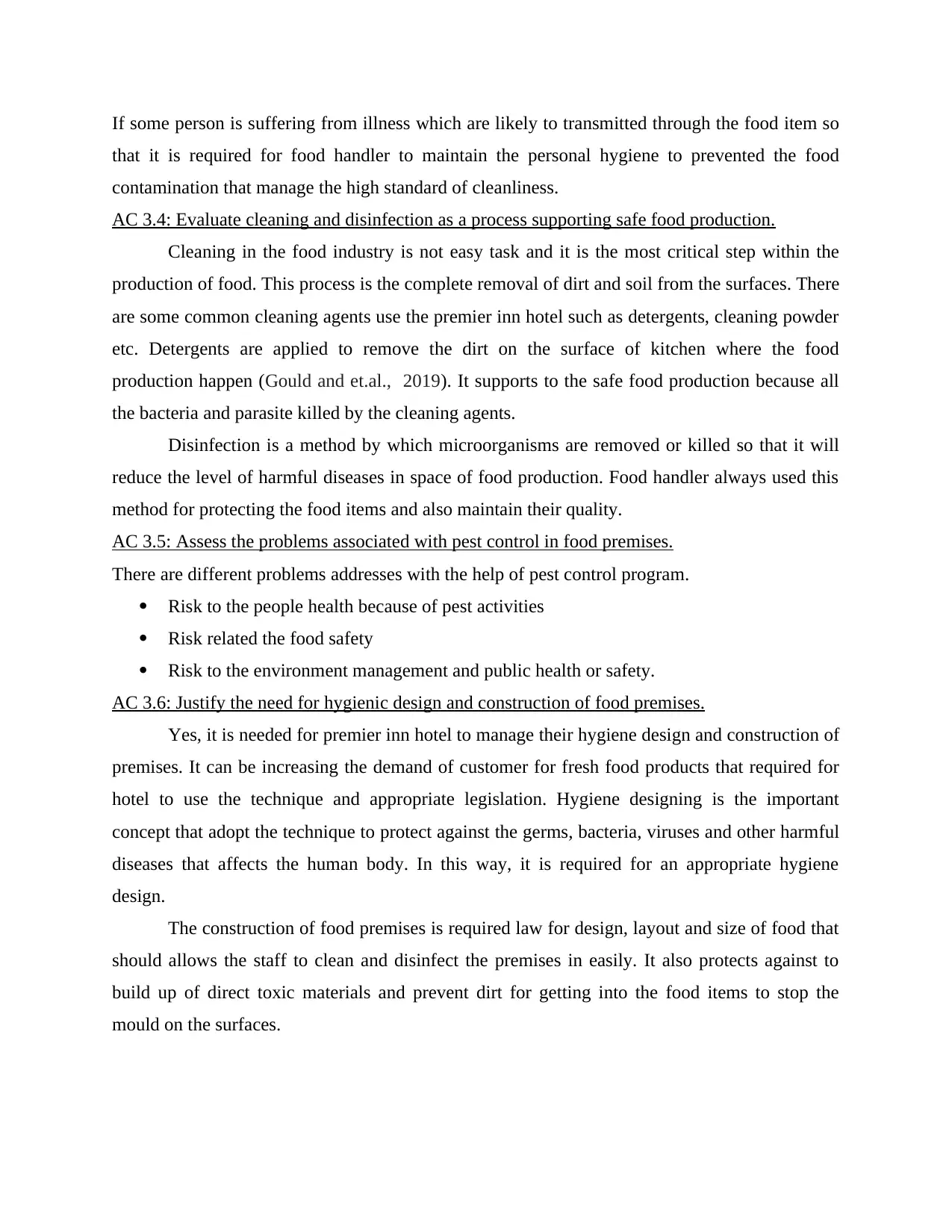
If some person is suffering from illness which are likely to transmitted through the food item so
that it is required for food handler to maintain the personal hygiene to prevented the food
contamination that manage the high standard of cleanliness.
AC 3.4: Evaluate cleaning and disinfection as a process supporting safe food production.
Cleaning in the food industry is not easy task and it is the most critical step within the
production of food. This process is the complete removal of dirt and soil from the surfaces. There
are some common cleaning agents use the premier inn hotel such as detergents, cleaning powder
etc. Detergents are applied to remove the dirt on the surface of kitchen where the food
production happen (Gould and et.al., 2019). It supports to the safe food production because all
the bacteria and parasite killed by the cleaning agents.
Disinfection is a method by which microorganisms are removed or killed so that it will
reduce the level of harmful diseases in space of food production. Food handler always used this
method for protecting the food items and also maintain their quality.
AC 3.5: Assess the problems associated with pest control in food premises.
There are different problems addresses with the help of pest control program.
Risk to the people health because of pest activities
Risk related the food safety
Risk to the environment management and public health or safety.
AC 3.6: Justify the need for hygienic design and construction of food premises.
Yes, it is needed for premier inn hotel to manage their hygiene design and construction of
premises. It can be increasing the demand of customer for fresh food products that required for
hotel to use the technique and appropriate legislation. Hygiene designing is the important
concept that adopt the technique to protect against the germs, bacteria, viruses and other harmful
diseases that affects the human body. In this way, it is required for an appropriate hygiene
design.
The construction of food premises is required law for design, layout and size of food that
should allows the staff to clean and disinfect the premises in easily. It also protects against to
build up of direct toxic materials and prevent dirt for getting into the food items to stop the
mould on the surfaces.
that it is required for food handler to maintain the personal hygiene to prevented the food
contamination that manage the high standard of cleanliness.
AC 3.4: Evaluate cleaning and disinfection as a process supporting safe food production.
Cleaning in the food industry is not easy task and it is the most critical step within the
production of food. This process is the complete removal of dirt and soil from the surfaces. There
are some common cleaning agents use the premier inn hotel such as detergents, cleaning powder
etc. Detergents are applied to remove the dirt on the surface of kitchen where the food
production happen (Gould and et.al., 2019). It supports to the safe food production because all
the bacteria and parasite killed by the cleaning agents.
Disinfection is a method by which microorganisms are removed or killed so that it will
reduce the level of harmful diseases in space of food production. Food handler always used this
method for protecting the food items and also maintain their quality.
AC 3.5: Assess the problems associated with pest control in food premises.
There are different problems addresses with the help of pest control program.
Risk to the people health because of pest activities
Risk related the food safety
Risk to the environment management and public health or safety.
AC 3.6: Justify the need for hygienic design and construction of food premises.
Yes, it is needed for premier inn hotel to manage their hygiene design and construction of
premises. It can be increasing the demand of customer for fresh food products that required for
hotel to use the technique and appropriate legislation. Hygiene designing is the important
concept that adopt the technique to protect against the germs, bacteria, viruses and other harmful
diseases that affects the human body. In this way, it is required for an appropriate hygiene
design.
The construction of food premises is required law for design, layout and size of food that
should allows the staff to clean and disinfect the premises in easily. It also protects against to
build up of direct toxic materials and prevent dirt for getting into the food items to stop the
mould on the surfaces.
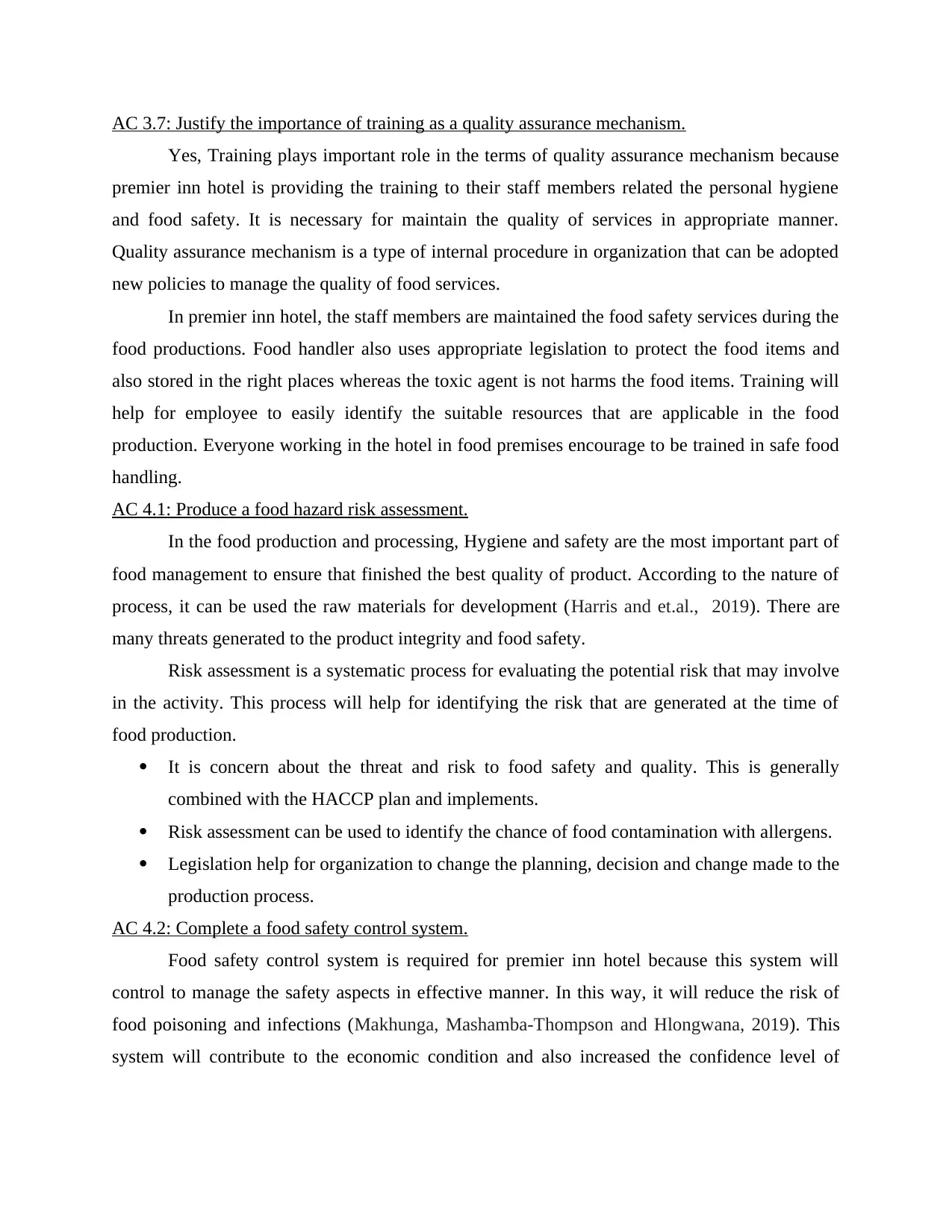
AC 3.7: Justify the importance of training as a quality assurance mechanism.
Yes, Training plays important role in the terms of quality assurance mechanism because
premier inn hotel is providing the training to their staff members related the personal hygiene
and food safety. It is necessary for maintain the quality of services in appropriate manner.
Quality assurance mechanism is a type of internal procedure in organization that can be adopted
new policies to manage the quality of food services.
In premier inn hotel, the staff members are maintained the food safety services during the
food productions. Food handler also uses appropriate legislation to protect the food items and
also stored in the right places whereas the toxic agent is not harms the food items. Training will
help for employee to easily identify the suitable resources that are applicable in the food
production. Everyone working in the hotel in food premises encourage to be trained in safe food
handling.
AC 4.1: Produce a food hazard risk assessment.
In the food production and processing, Hygiene and safety are the most important part of
food management to ensure that finished the best quality of product. According to the nature of
process, it can be used the raw materials for development (Harris and et.al., 2019). There are
many threats generated to the product integrity and food safety.
Risk assessment is a systematic process for evaluating the potential risk that may involve
in the activity. This process will help for identifying the risk that are generated at the time of
food production.
It is concern about the threat and risk to food safety and quality. This is generally
combined with the HACCP plan and implements.
Risk assessment can be used to identify the chance of food contamination with allergens.
Legislation help for organization to change the planning, decision and change made to the
production process.
AC 4.2: Complete a food safety control system.
Food safety control system is required for premier inn hotel because this system will
control to manage the safety aspects in effective manner. In this way, it will reduce the risk of
food poisoning and infections (Makhunga, Mashamba-Thompson and Hlongwana, 2019). This
system will contribute to the economic condition and also increased the confidence level of
Yes, Training plays important role in the terms of quality assurance mechanism because
premier inn hotel is providing the training to their staff members related the personal hygiene
and food safety. It is necessary for maintain the quality of services in appropriate manner.
Quality assurance mechanism is a type of internal procedure in organization that can be adopted
new policies to manage the quality of food services.
In premier inn hotel, the staff members are maintained the food safety services during the
food productions. Food handler also uses appropriate legislation to protect the food items and
also stored in the right places whereas the toxic agent is not harms the food items. Training will
help for employee to easily identify the suitable resources that are applicable in the food
production. Everyone working in the hotel in food premises encourage to be trained in safe food
handling.
AC 4.1: Produce a food hazard risk assessment.
In the food production and processing, Hygiene and safety are the most important part of
food management to ensure that finished the best quality of product. According to the nature of
process, it can be used the raw materials for development (Harris and et.al., 2019). There are
many threats generated to the product integrity and food safety.
Risk assessment is a systematic process for evaluating the potential risk that may involve
in the activity. This process will help for identifying the risk that are generated at the time of
food production.
It is concern about the threat and risk to food safety and quality. This is generally
combined with the HACCP plan and implements.
Risk assessment can be used to identify the chance of food contamination with allergens.
Legislation help for organization to change the planning, decision and change made to the
production process.
AC 4.2: Complete a food safety control system.
Food safety control system is required for premier inn hotel because this system will
control to manage the safety aspects in effective manner. In this way, it will reduce the risk of
food poisoning and infections (Makhunga, Mashamba-Thompson and Hlongwana, 2019). This
system will contribute to the economic condition and also increased the confidence level of
⊘ This is a preview!⊘
Do you want full access?
Subscribe today to unlock all pages.

Trusted by 1+ million students worldwide
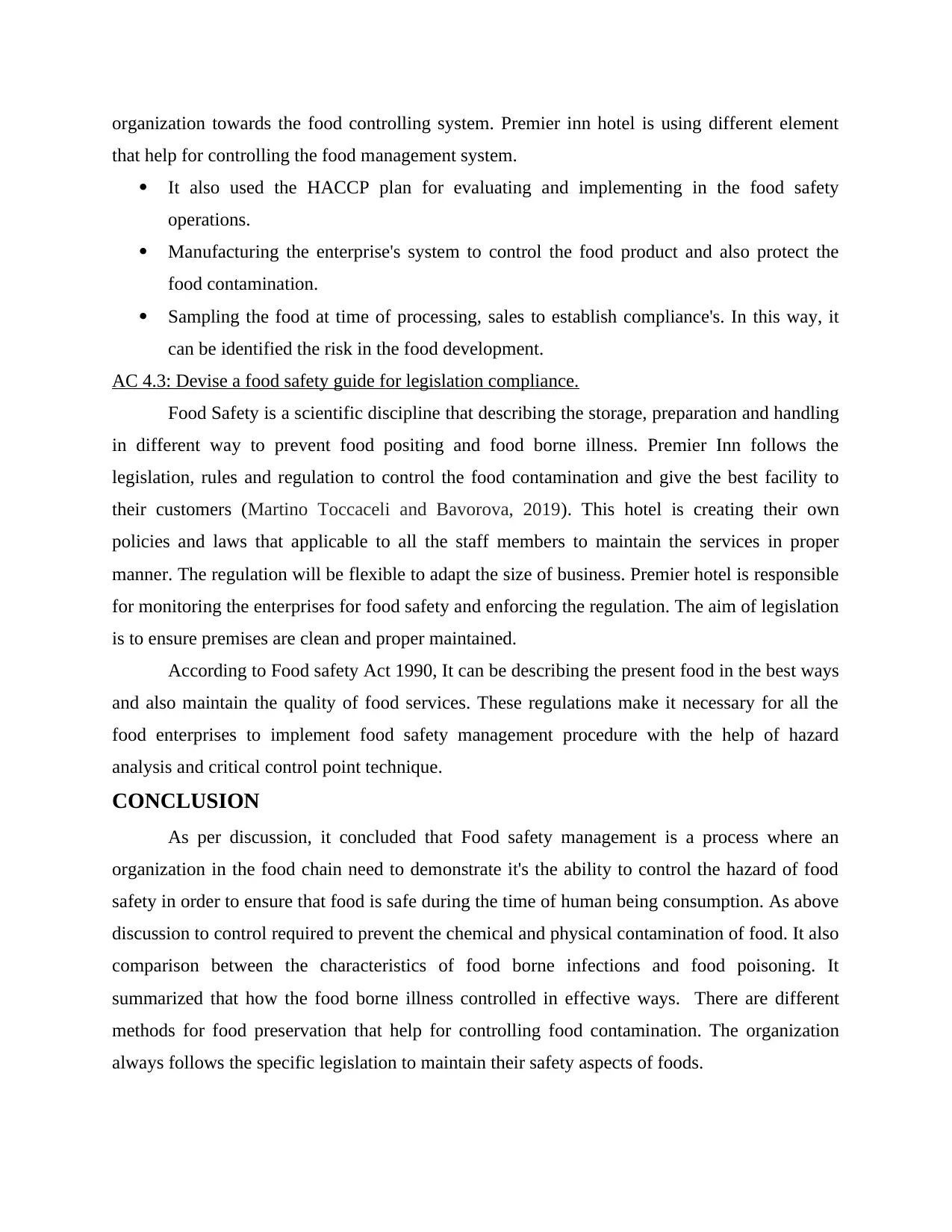
organization towards the food controlling system. Premier inn hotel is using different element
that help for controlling the food management system.
It also used the HACCP plan for evaluating and implementing in the food safety
operations.
Manufacturing the enterprise's system to control the food product and also protect the
food contamination.
Sampling the food at time of processing, sales to establish compliance's. In this way, it
can be identified the risk in the food development.
AC 4.3: Devise a food safety guide for legislation compliance.
Food Safety is a scientific discipline that describing the storage, preparation and handling
in different way to prevent food positing and food borne illness. Premier Inn follows the
legislation, rules and regulation to control the food contamination and give the best facility to
their customers (Martino Toccaceli and Bavorova, 2019). This hotel is creating their own
policies and laws that applicable to all the staff members to maintain the services in proper
manner. The regulation will be flexible to adapt the size of business. Premier hotel is responsible
for monitoring the enterprises for food safety and enforcing the regulation. The aim of legislation
is to ensure premises are clean and proper maintained.
According to Food safety Act 1990, It can be describing the present food in the best ways
and also maintain the quality of food services. These regulations make it necessary for all the
food enterprises to implement food safety management procedure with the help of hazard
analysis and critical control point technique.
CONCLUSION
As per discussion, it concluded that Food safety management is a process where an
organization in the food chain need to demonstrate it's the ability to control the hazard of food
safety in order to ensure that food is safe during the time of human being consumption. As above
discussion to control required to prevent the chemical and physical contamination of food. It also
comparison between the characteristics of food borne infections and food poisoning. It
summarized that how the food borne illness controlled in effective ways. There are different
methods for food preservation that help for controlling food contamination. The organization
always follows the specific legislation to maintain their safety aspects of foods.
that help for controlling the food management system.
It also used the HACCP plan for evaluating and implementing in the food safety
operations.
Manufacturing the enterprise's system to control the food product and also protect the
food contamination.
Sampling the food at time of processing, sales to establish compliance's. In this way, it
can be identified the risk in the food development.
AC 4.3: Devise a food safety guide for legislation compliance.
Food Safety is a scientific discipline that describing the storage, preparation and handling
in different way to prevent food positing and food borne illness. Premier Inn follows the
legislation, rules and regulation to control the food contamination and give the best facility to
their customers (Martino Toccaceli and Bavorova, 2019). This hotel is creating their own
policies and laws that applicable to all the staff members to maintain the services in proper
manner. The regulation will be flexible to adapt the size of business. Premier hotel is responsible
for monitoring the enterprises for food safety and enforcing the regulation. The aim of legislation
is to ensure premises are clean and proper maintained.
According to Food safety Act 1990, It can be describing the present food in the best ways
and also maintain the quality of food services. These regulations make it necessary for all the
food enterprises to implement food safety management procedure with the help of hazard
analysis and critical control point technique.
CONCLUSION
As per discussion, it concluded that Food safety management is a process where an
organization in the food chain need to demonstrate it's the ability to control the hazard of food
safety in order to ensure that food is safe during the time of human being consumption. As above
discussion to control required to prevent the chemical and physical contamination of food. It also
comparison between the characteristics of food borne infections and food poisoning. It
summarized that how the food borne illness controlled in effective ways. There are different
methods for food preservation that help for controlling food contamination. The organization
always follows the specific legislation to maintain their safety aspects of foods.
Paraphrase This Document
Need a fresh take? Get an instant paraphrase of this document with our AI Paraphraser
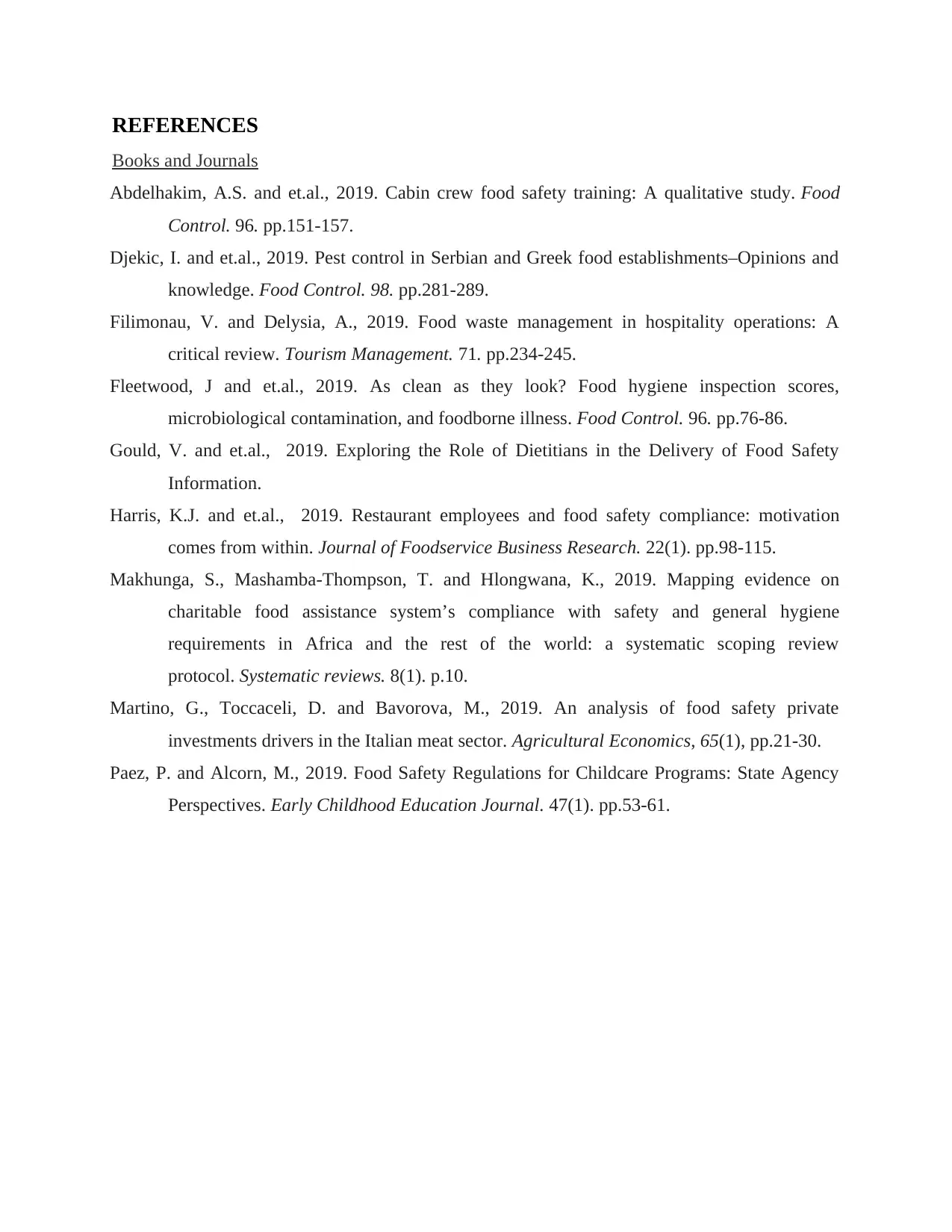
REFERENCES
Books and Journals
Abdelhakim, A.S. and et.al., 2019. Cabin crew food safety training: A qualitative study. Food
Control. 96. pp.151-157.
Djekic, I. and et.al., 2019. Pest control in Serbian and Greek food establishments–Opinions and
knowledge. Food Control. 98. pp.281-289.
Filimonau, V. and Delysia, A., 2019. Food waste management in hospitality operations: A
critical review. Tourism Management. 71. pp.234-245.
Fleetwood, J and et.al., 2019. As clean as they look? Food hygiene inspection scores,
microbiological contamination, and foodborne illness. Food Control. 96. pp.76-86.
Gould, V. and et.al., 2019. Exploring the Role of Dietitians in the Delivery of Food Safety
Information.
Harris, K.J. and et.al., 2019. Restaurant employees and food safety compliance: motivation
comes from within. Journal of Foodservice Business Research. 22(1). pp.98-115.
Makhunga, S., Mashamba-Thompson, T. and Hlongwana, K., 2019. Mapping evidence on
charitable food assistance system’s compliance with safety and general hygiene
requirements in Africa and the rest of the world: a systematic scoping review
protocol. Systematic reviews. 8(1). p.10.
Martino, G., Toccaceli, D. and Bavorova, M., 2019. An analysis of food safety private
investments drivers in the Italian meat sector. Agricultural Economics, 65(1), pp.21-30.
Paez, P. and Alcorn, M., 2019. Food Safety Regulations for Childcare Programs: State Agency
Perspectives. Early Childhood Education Journal. 47(1). pp.53-61.
Books and Journals
Abdelhakim, A.S. and et.al., 2019. Cabin crew food safety training: A qualitative study. Food
Control. 96. pp.151-157.
Djekic, I. and et.al., 2019. Pest control in Serbian and Greek food establishments–Opinions and
knowledge. Food Control. 98. pp.281-289.
Filimonau, V. and Delysia, A., 2019. Food waste management in hospitality operations: A
critical review. Tourism Management. 71. pp.234-245.
Fleetwood, J and et.al., 2019. As clean as they look? Food hygiene inspection scores,
microbiological contamination, and foodborne illness. Food Control. 96. pp.76-86.
Gould, V. and et.al., 2019. Exploring the Role of Dietitians in the Delivery of Food Safety
Information.
Harris, K.J. and et.al., 2019. Restaurant employees and food safety compliance: motivation
comes from within. Journal of Foodservice Business Research. 22(1). pp.98-115.
Makhunga, S., Mashamba-Thompson, T. and Hlongwana, K., 2019. Mapping evidence on
charitable food assistance system’s compliance with safety and general hygiene
requirements in Africa and the rest of the world: a systematic scoping review
protocol. Systematic reviews. 8(1). p.10.
Martino, G., Toccaceli, D. and Bavorova, M., 2019. An analysis of food safety private
investments drivers in the Italian meat sector. Agricultural Economics, 65(1), pp.21-30.
Paez, P. and Alcorn, M., 2019. Food Safety Regulations for Childcare Programs: State Agency
Perspectives. Early Childhood Education Journal. 47(1). pp.53-61.

⊘ This is a preview!⊘
Do you want full access?
Subscribe today to unlock all pages.

Trusted by 1+ million students worldwide
1 out of 12
Related Documents
Your All-in-One AI-Powered Toolkit for Academic Success.
+13062052269
info@desklib.com
Available 24*7 on WhatsApp / Email
![[object Object]](/_next/static/media/star-bottom.7253800d.svg)
Unlock your academic potential
Copyright © 2020–2025 A2Z Services. All Rights Reserved. Developed and managed by ZUCOL.





